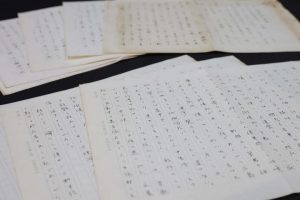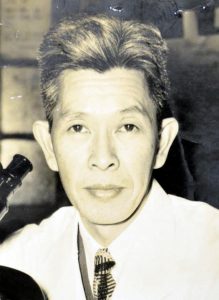Documenting Hiroshima of 1945: October 15–16, publication suspended of account describing experiences in A-bombing
Oct. 16, 2024
by Kyosuke Mizukawa, Senior Staff Writer
On October 15 and 16th, 1945, an assistant of Kiyoshi Kanai, an engineer who worked at a seismic research institute within Tokyo Imperial University (present-day University of Tokyo) who died in 2008 at the age of 100, was working to transcribe one account of the experiences of a survivor in the atomic bombing. The account described in detail the devastation of Hiroshima, the city Mr. Kanai was scheduled to soon visit when he joined a special task force for investigation of destruction from the atomic bombing formed by a research council at the Japan Ministry of Education.
The account was written by Seiji Kimoto, an assistant professor at the surgery department of the university’s medical school who died in 1995 at the age of 87. Mr. Kimoto and Mr. Kanai, who was originally from Hiroshima City, had been classmates at Hiroshima First Middle School (present-day Kokutaiji High School). During a return to his hometown, Mr. Kimoto had experienced the atomic bombing at his birth home located in the area of Ushita-cho (in Hiroshima’s present-day Higashi Ward), around three kilometers from the hypocenter.
Mr. Kimoto wrote, “My body was spun around and bounced against the earthen floor. I felt as if my left eardrum had ruptured after hearing a loud bang,” adding, “Even in front of this writer’s house, three kilometers from the hypocenter, some people had been burned to death.” The account was written at the request of a magazine publisher and described the damage from the atomic bombing through the writer’s detached observations as a scientist.
However, the account was not released to the public at that time. Mr. Kimoto later revealed in his recollections titled Igaku to Watashi (in English, ‘Medicine and I’), published in 1981, that the publication of his account had been “suspended by the General Headquarters of the Allied Powers (GHQ).”
Still unclear is what magazine was scheduled to carry the account, but chances are it was the October 1945 issue of the Japan Medical Journal, because one part of the account seems to have been written based on the assumption that it would be run simultaneously with a survey report of A-bombing damages authored by Tokyo Imperial University’s Masao Tsuzuki that was carried in the same issue.
Why the publication of only Mr. Kimoto’s account was “suspended” is unclear. However, because it was a personal account, some of the depictions of the A-bombing tragedy stand out, such as its descriptions of “scenes of hell” and that “the bomb killed every living creature, causing them to wither and die.” The press code issued by the GHQ on September 19 included the provision that, “There shall be no destructive criticism of the Allied Forces of Occupation and nothing which might invite mistrust or resentment of these troops.”
Mr. Kimoto’s original handwritten account later went missing. The donation to the Hiroshima Peace Memorial Museum in 2018 of the transcribed text in Mr. Kanai’s office led to public awareness about the account’s existence and contents.
(Originally published on October 16, 2024)
On October 15 and 16th, 1945, an assistant of Kiyoshi Kanai, an engineer who worked at a seismic research institute within Tokyo Imperial University (present-day University of Tokyo) who died in 2008 at the age of 100, was working to transcribe one account of the experiences of a survivor in the atomic bombing. The account described in detail the devastation of Hiroshima, the city Mr. Kanai was scheduled to soon visit when he joined a special task force for investigation of destruction from the atomic bombing formed by a research council at the Japan Ministry of Education.
The account was written by Seiji Kimoto, an assistant professor at the surgery department of the university’s medical school who died in 1995 at the age of 87. Mr. Kimoto and Mr. Kanai, who was originally from Hiroshima City, had been classmates at Hiroshima First Middle School (present-day Kokutaiji High School). During a return to his hometown, Mr. Kimoto had experienced the atomic bombing at his birth home located in the area of Ushita-cho (in Hiroshima’s present-day Higashi Ward), around three kilometers from the hypocenter.
Mr. Kimoto wrote, “My body was spun around and bounced against the earthen floor. I felt as if my left eardrum had ruptured after hearing a loud bang,” adding, “Even in front of this writer’s house, three kilometers from the hypocenter, some people had been burned to death.” The account was written at the request of a magazine publisher and described the damage from the atomic bombing through the writer’s detached observations as a scientist.
However, the account was not released to the public at that time. Mr. Kimoto later revealed in his recollections titled Igaku to Watashi (in English, ‘Medicine and I’), published in 1981, that the publication of his account had been “suspended by the General Headquarters of the Allied Powers (GHQ).”
Still unclear is what magazine was scheduled to carry the account, but chances are it was the October 1945 issue of the Japan Medical Journal, because one part of the account seems to have been written based on the assumption that it would be run simultaneously with a survey report of A-bombing damages authored by Tokyo Imperial University’s Masao Tsuzuki that was carried in the same issue.
Why the publication of only Mr. Kimoto’s account was “suspended” is unclear. However, because it was a personal account, some of the depictions of the A-bombing tragedy stand out, such as its descriptions of “scenes of hell” and that “the bomb killed every living creature, causing them to wither and die.” The press code issued by the GHQ on September 19 included the provision that, “There shall be no destructive criticism of the Allied Forces of Occupation and nothing which might invite mistrust or resentment of these troops.”
Mr. Kimoto’s original handwritten account later went missing. The donation to the Hiroshima Peace Memorial Museum in 2018 of the transcribed text in Mr. Kanai’s office led to public awareness about the account’s existence and contents.
(Originally published on October 16, 2024)









